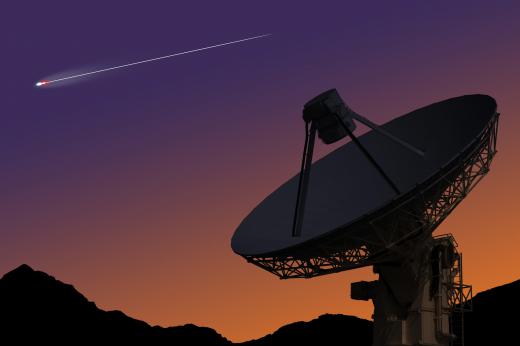What is a Galaxy?
 Michael Anissimov
Michael Anissimov
A galaxy is a cluster of stars, nebulae, dark matter, and other astronomical objects. Most galaxies are tens of thousands of light years in diameter, and contain billions of stars. Galaxies come in three primary shapes; spiral galaxies are thin disks, with spiral arms surrounding a central hub; elliptical galaxies are uniform, oval-shaped agglomerations; and irregular galaxies have little or no definite structure.
A spiral galaxy centers around a hub, which is roughly spherical and bulges outward from the disk. The hub is the gravitational center of the galaxy, and usually contains a supermassive black hole. Surrounding the hub are spiral arms, which are bunched-up waves of stars and gas orbiting the center. The spiral arms usually have more gas and dust, and they contain most of the newly formed stars, which make them appear blue in color imagery. A spiral galaxy may have a horizontal bar passing through its hub; our own galaxy, the Milky Way, is believed to contain a bar.

Elliptical galaxies have a large, central hub, but they lack the arms of a spiral galaxy; they usually appear more yellowish in color imagery from old, reddish stars. Irregular galaxies often have no discernible structure, but often they can be recognized as having a distorted spiral or elliptical shape. Elliptical and irregular galaxies often result from collisions, which cause large bursts of star formation and distort the galaxies' structure due to the complex gravitational interactions. Eventually, the two galaxies usually merge to form one large galaxy, which has cast off most of its gas and dust clouds.

There are roughly a hundred billion galaxies in the visible universe; most of them occur in large agglomerations called galaxy superclusters. Between these superclusters are voids with few or no galaxies, often for a hundred million light years or more. By studying the rotation of spiral galaxies, astronomers found that most of the matter in the universe is not stars and gas, but invisible “dark matter” which cannot be seen but still exerts gravity. Dark matter is thought to be responsible for these large clusters, as the gravitational attraction of the dark matter pulled galaxies together.
AS FEATURED ON:
AS FEATURED ON:















Discussion Comments
How can we distinguish between a galaxy and star clusters?
How do we prove whether our universe is endless (no limit or boundaries) or not?
@anon6289- Most astronomers agree that the solar system is around 4.6 billion years old. To determine the age of our solar system, scientists study meteorites with a technique called radioactive dating. With radioactive dating, scientists can tell how long ago a meteorite was formed and how long it took for the different layers of the meteorite to decay. This helps to determine the age.
1.How old is the solar system?
2.what is the relationship between the galaxy and the solar system?
Post your comments